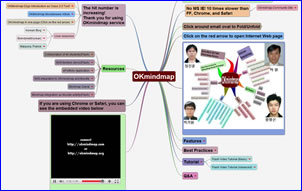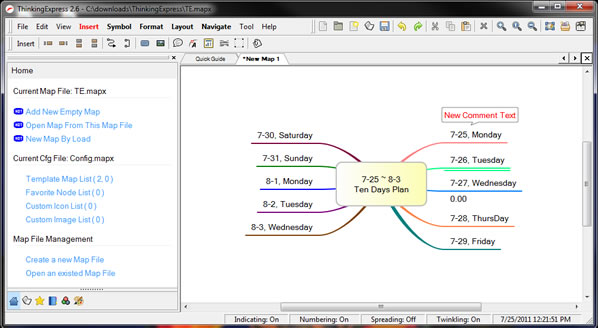Despite a global market in which dozens of existing mind mapping software applications are fighting for survival, more new tools continue to be developed and announced. The latest two that have arrived on my radar screen are OKMindMap and ThinkingExpress.
ThinkingExpress (see screen shot above) is a very basic Windows mind mapping app that its developer says is only 800 KB in size. That means you could easily carry the program and any mind maps you created using it on a memory stick. It enables you to include icons, hypertext links, topic comments and more. I downloaded it and played around with it a bit. It actually feels more polished than FreeMind in some ways.
 OKMindMap (see screen shot at right) claims to be the world’s first web-based mind mapping tool developed using scalable vector graphics (SVG) – in other words, it doesn’t require a Flash-equipped browser. That should be good news for users of iPhones and iPads! It can integrate feeds from social media services like Facebook, Delicious and Twitter, and video can be embedded in maps created with the service. Clearly, its developers are focused on the educational market, because many of the resources on the OKMindMap support website are focused on enabling students to collaborate and posting maps to Moodle, an open-source learning management system used by community colleges and other types of schools to host training content. You can read a complete review here.
OKMindMap (see screen shot at right) claims to be the world’s first web-based mind mapping tool developed using scalable vector graphics (SVG) – in other words, it doesn’t require a Flash-equipped browser. That should be good news for users of iPhones and iPads! It can integrate feeds from social media services like Facebook, Delicious and Twitter, and video can be embedded in maps created with the service. Clearly, its developers are focused on the educational market, because many of the resources on the OKMindMap support website are focused on enabling students to collaborate and posting maps to Moodle, an open-source learning management system used by community colleges and other types of schools to host training content. You can read a complete review here.
Here’s hoping these new tools find their niches. But I must emphasize that the odds are stacked against them. There are so many desktop, web and mobile-based mind mapping tools on the market that people are confused. It’s already hard for them to tell which tool is the best fit for their needs. I get asked questions about this all the time, and I frequently see similar requests on Twitter. People are confused by all of the choices surrounding them.
I suggest that if you’re a developer, and you’re thinking about creating a new mind mapping tool, regardless of the platform you’re targeting, that you think twice before proceeding. In particular, it’s not enough to create another me-too visual mapping tool. You need to be pushing the envelope in some ways that are meaningful to potential users. Otherwise your tool will just get lost in the “noise” of an overly-crowded marketplace.


Leave a Reply